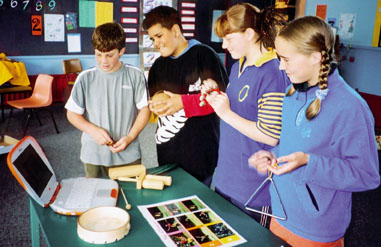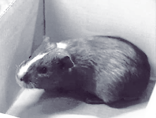|
|
:
English Version |
|
|
|
||
|
Acknowledgments
The Project directors acknowledge the vital support and contributions of many people to this report, including:
New Zealand’s National Education Monitoring Project commenced in 1993, with the task of assessing and reporting on the achievement of New Zealand primary school children in all areas of the school curriculum. Children are assessed at two class levels: Year 4 (halfway through primary education) and year 8 (at the end of primary education). Different curriculum areas and skills are assessed each year, over a four year cycle. In 1999, the areas covered were science, art, and the use of graphs, tables and maps. The main goal of national monitoring is to provide detailed information about what children can do so that patterns of performance can be recognised, successes celebrated, and desirable changes to educational practices and resources identified and implemented. Each
year, small random samples of children are selected nationally, then
assessed in their own schools by teachers specially seconded and trained
for this work. Task instructions are given orally by teachers, through
video presentations, on laptop computers, or in writing. Many of the
assessment tasks involve the children in the use of equipment and
supplies. Their responses are presented orally, by demonstration,
in writing, in computer files, or through submission of other physical
products. Many of the responses are recorded on videotape for subsequent
analysis.
This report focuses solely on year 8 students. Starting in 1999, assessments of students learning in Mäori immersion programmes were added to the national monitoring programme, at the year 8 level only. In 2000, about 60 percent of these Mäori immersion students were learning in immersion schools (mainly Kura Kaupapa Mäori), while the other 40 percent were learning in immersion classes (located in mainstream schools, but having 80 to 100 percent of instruction conducted in Mäori). For this special sample, the assessment tasks and task materials were translated into Mäori and administered by teachers experienced in Mäori immersion settings. The results these students achieved are reported here, together with comparative figures for Mäori students in the main year 8 national monitoring sample (whose schooling was conducted predominantly in English).
Chapter 1 explains key features of the National Education Monitoring Project that are relevant to this report.
Chapter 2 explains some issues affecting the interpretation of the assessments in Mäori immersion settings, and especially the comparisons of the achievements of Mäori students in general education and Mäori immersion programmes. One issue is that some of the students in Mäori immersion settings had not yet developed sufficient skills in te reo Mäori to fully understand task instructions or to communicate their responses well. The selected Mäori immersion schools were asked to indicate which of their students had completed more than four years of immersion education, and national monitoring samples were selected from these experienced students. Nevertheless, some of the selected students still struggled with communication in Mäori, and a few would have preferred to be assessed in English. Another
issue involved the translation of tasks and material from English
to Mäori. Improved procedures in 2000 addressed the more serious
translation problems experienced in 1999, but ensuring that students
assessed in two different languages are facing equivalent tasks remains
a major challenge.
Chapter 3 presents results of the assessments of students’ knowledge, understanding and skills in music. Music education gives learners opportunities to develop their aesthetic appreciation, their capacities for original and imaginative expression, and their abilities to use and interpret musical elements for a variety of purposes and with a range of materials. Music education can help students become aware of the distinctive functions of music in society and to know about the artistic heritage of their own and other cultures. Thirteen music tasks were administered to individual Mäori students in both general education and Mäori immersion settings. They addressed four fundamental processes: creating music, re-creating music, responding to music and understanding music. Mäori students in general education and Mäori students in Mäori immersion settings performed equally well on nine of the thirteen tasks. Students in immersion programmes scored statistically significantly higher on one task and Mäori students in general education scored statistically significantly higher on three tasks.
Chapter 4 presents results of the assessments of students' knowledge, understanding and skills in aspects of technology. Technology is a creative, purposeful activity aimed at meeting needs and opportunities through the development of products, systems or environments. Knowledge, skills and resources are combined to help solve practical problems in particular social contexts. Technology is a multi-disciplinary activity, and in the national monitoring assessments only some key aspects could be assessed. Seventeen technology tasks were admin-istered to individual Mäori students in both general education settings and Mäori immersion settings. These tasks addressed the three strands of the technology curriculum: technological knowledge and understanding, technological capability, and technology and society. Mäori students in general education and Mäori students in Mäori immersion settings performed equally well on nine tasks. Students in immersion programmes scored statistically significantly higher on two tasks and Mäori students in general education scored statistically significantly higher on six tasks.
Chapter 5 presents the results of the assessments of students’ skills in reading and speaking. The purpose of language is communication. Communication is a process of sharing knowledge, experiences, information, ideas and feelings. Because communication is essentially an interactive process, the oral, written and visual components of language are highly interrelated. The ability to read and present a play, for example, combines skills of reading and speaking. For this reason, the tasks discussed here cannot neatly be divided into two categories. Some predominantly involve reading, some predominantly involve speaking, and others involve a more equal mix of reading and speaking. Twelve reading and speaking tasks were administered to individual Mäori students in both general education settings and Mäori immersion settings. Two tasks required all students to read Mäori words or text, although the task instructions were given in English for the Mäori students in general education settings. The other ten tasks were presented in English for the Mäori students in general education and in Mäori for the students in Mäori immersion settings, but involved the same instructions and content in translation. Mäori students in general education and Mäori students in Mäori immersion settings performed equally well on five tasks. Students in Mäori immersion programmes scored statistically significantly higher on three tasks (including the two tasks involving reading of Mäori words or text) and Mäori students in general education scored statistically significantly higher on four tasks.
Chapter 6 reports the results of surveys of students about their curriculum preferences and perceptions of their achievement and potential in music, technology, reading and speaking.
The most notable findings from the music survey were that, compared to Mäori students in general education, students in Mäori immersion programmes reported greater involvement in and enjoyment of singing, both in and outside of school. They also said that they spent less time listening to music out of school time, and expressed lower levels of enjoyment of listening to music both in and out of school. Both
groups saw making and designing as the most important aspect of technology,
but students in Mäori immersion programmes also gave strong prominence
to computer use. Compared to Mäori students in general education,
about twenty percent more Mäori immersion students were very
positive about how good they were at technology. In the reading and speaking surveys, there were a number of notable differences between the response patterns for Mäori students in general education and students in Mäori immersion programmes. When identifying important things to do to be a good reader, Mäori immersion students emphasised learning hard words, listening to the teacher, and thinking about what they read. They placed less emphasis on concentrating hard, enjoying reading books, and choosing the right book. They were more positive about reading at school, getting a book for a present, and looking at books in a bookshop, but less positive about their teacher reading a story out loud and about talking to their whole class. They reported fewer opportunities to talk to their whole class or to others in their class. Ten percent of Mäori in general education and 35 percent of Mäori immersion students indicated that Mäori was the main language spoken at home.
Overall, in the curriculum areas covered by this report, Mäori students learning in Mäori immersion settings and those learning in English language settings performed similarly on 55 percent of the tasks. Students in Mäori immersion settings scored higher on 14 percent of the tasks, while Mäori students in general education scored higher on 31 percent of the tasks. These results should be interpreted cautiously, for the reasons presented in Chapter 2. Over the next few years, as experience leads to improved assessments and Mäori immersion education continues its development, the results should become more meaningful. Many immersion schools and classes have been operating for just a few years, with very limited resources. |


